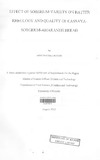| dc.description.abstract | Bread made from sorghum-based flours has poor textural characteristics. This is because sorghum has certain physico-chemical properties which negatively affect its functionality in gluten-free bread. In this study, the effect of sorghum variety on batter rheology and bread quality of cassava-sorghum-amaranth bread was investigated. The physico-chemical properties of six native and five malted (germinated) sorghum varieties and characteristics of cassava-sorghum-amaranth batters and breads were evaluated. In addition, the impact of storage time on the textural parameters of gluten-free bread was also determined.
Native and malt flour characterization included proximate composition, starch, damaged starch, total soluble sugars, reducing sugars, pasting properties, diastatic power, free amino nitrogen and tannin content. Sorghum varieties were malted and the one with the highest diastatic power was used for rheological and textural quality tests of the gluten-free batter and bread, respectively. Composite flour comprising cassava starch, sorghum and amaranth flours and modified with malt was used to formulate gluten-free batter and bread.
Sorghum grain colour varied between white and reddish brown while lOOO-kernel weight and hardness were 16.62-27.76 g and 1.34-2.64 Nᄋs, respectively. There was variability in native and malt flour characteristics. Malted flour had significantly higher (P :s 0.05) damaged starch, total soluble sugars, reducing sugars, diastatic activity and free amino nitrogen, but significantly lower (P :s 0.05) in tannins and peak viscosity than native flour. The consistencies of the batters ranged between 76.03 and 216.90 N. Crumb hardness, springiness, resilience, cohesiveness and chewiness were 12.02-47.43 N, 81.27- 87.13%, 0.21-0.27, 0.42-0.55 and 5.80-17.20 N after 24 h, respectively. Crumb \, hardness and chewiness increased with storage, however, resilience and cohesiveness did not change significantly (P> 0.05).
Sorghum variety with highest amount of damaged starch (10.73%) gave least firm (12.02 N) and least chewy (5.80 N) crumb after 24 h. Genotypic variations were observed in characterisation of native and malted sorghum varieties, rheology and quality of cassava-sorghumamaranth batter and bread, respectively. There is potential for blending of cassava starch, sorghum and amaranth flours in breadmaking. If institutionalised, it can create a positive impact on production and commercialisation of cassava, sorghum and amaranth as well as teduce wheat import to the country. These crops if developed and produced in Kenya would enhance food diversification and food security by tapping their unexploited potential. | en_US |

